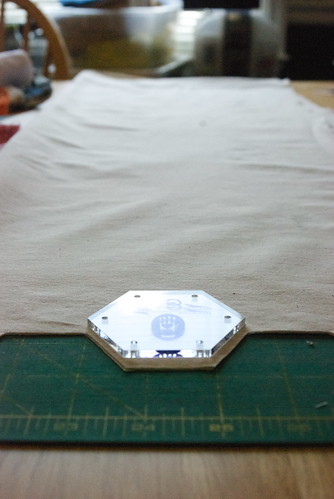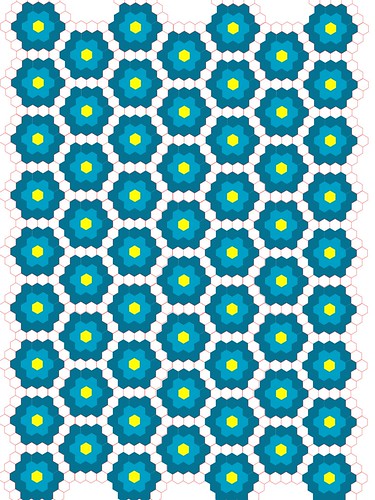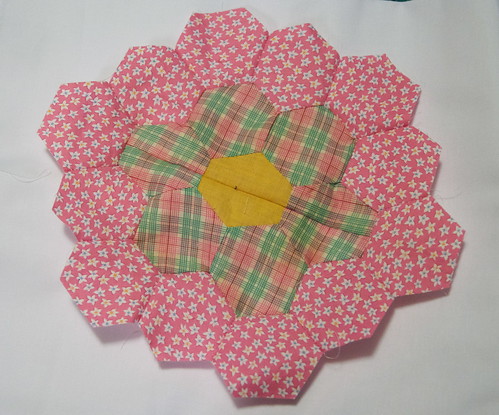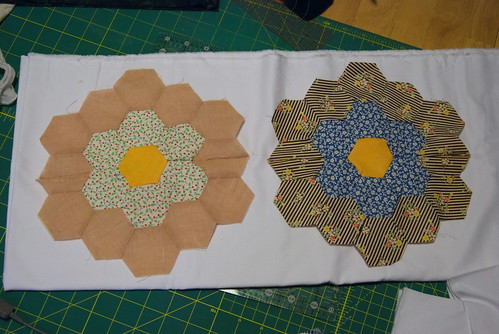hexatrix
I've put some craft time this week toward Hallie's hexagon project, which I nicknamed "Remixed." I teased Jeff tonight that I wanted to sit down and actally sew something, so I could say that I was finally making progress on the quilt project. Everything I'd done so far felt more like deconstruction than construction.
Here's a recap, if you're not familiar. Hallie has a lot of quilt pieces she inherited from either her great-aunt or her great-grandmother. I worked up the first set into a quilt a few months ago, and agreed that at some point I'd tackle the second set -- the hexagons.
I photographed all of the full and half hexes some time ago, and played around with them in Illustrator to get some idea of what I wanted to do.
 Items Not To Scale[tm]
Items Not To Scale[tm]
['Items Not To Scale[tm]']
While I was in Atlanta last, I hit up Intown Quilters with hexagons in hand, and raided the 1930s reproduction fabrics. I kept paring down, and down, and down, until I had just a few fabrics whose prints blended well with the existing fabrics in terms of color and print scale.
 New fabrics to match the old
New fabrics to match the old
['New fabrics to match the old']
I learned that there was a quick way, or a fabric-efficient way, to cut hexagons. Pick one. Doing it quickly meant slicing long strips, cutting out hexes, and wasting lots of little triangles of fabric. Or, I could take the slower approach and cut out a hexagon at a time, slowly working my way up the fabric, cutting only a single hex at a time but wasting almost nothing.
 Everything new will be old again
Everything new will be old again
['Everything new will be old again']
and yes, this was daunting, but I did eventually finish cutting all the fabric:
 Smokey, meet Bandit
Smokey, meet Bandit
['Smokey, meet Bandit']
Last week, I finally asked myself the question, "How many hexes would I need to do the full Grandmother's Flower Garden treatment for a full-sized quilt?"
 'So, how many?' I asked.
'So, how many?' I asked.
['"So, how many?" I asked.']
Answer: 60. I had about 37-40 full hexes, and a pile of about 27 half-hexes. The halves just weren't useful, and they presented an opportunity that gave the quilt its name. What if I unpicked some of the seams on these half-hexes and salvaged them for parts? Pick off two outer unmatching rings to get two inner matching rings:
Add in a ring of new fabric and -- boom! -- a finished hex, blended of old and new fabrics.
 Half new, half old.
Half new, half old.
['Half old, half new']
Oh, and those outer rings left over?
 Exteriors awaiting salvaging
Exteriors awaiting salvaging
['Exteriors awaiting salvaging']
If there are matches, build new inner portions for them and get full hexes out of those:
 More half-and-half, sir?
More half-and-half, sir?
['More half-and-half, sir?']
The outer ring of a half-hex is 5 full pieces plus 2 half-pieces. If there isn't a match for that outer ring, it can be disassembled, re-sewn, and turned into an inner ring. My goal is to build as few completely-reproduction hexes as possible; I'd rather blend the old and the new so that within a few years, it'll be difficult to tell which fabrics were truly 1930s and which ones were just meant to look like 1930s.
That's the procedure, anyway.
I've been growling at these fabrics, and the unseen seamstress, for most of this week. Whoever she was, she put knots at the beginning and end of each hex, and many of them have been fiendishly difficult to remove without damaging the fabric. My choice to only partially unpick the hexes wasn't just altruistic; I was damned sick of dealing with these old knots. I'd rather leave as much knotted handiwork intact as possible.
I like the project, though. It's provided a surprising level of contentment. It doesn't have to be done soon. No one's waiting on it. If I want to make some progress, I can pick up a couple of pieces, work on them, and then put them aside. It feels relaxed, for now. When I've hit 60 hexes and it's time to start assembling, I will probably start treating it like any other quilt project -- time to sit down, tune everything else out, and power through until it's done -- but for now it's idle, low-key work during downtime.

